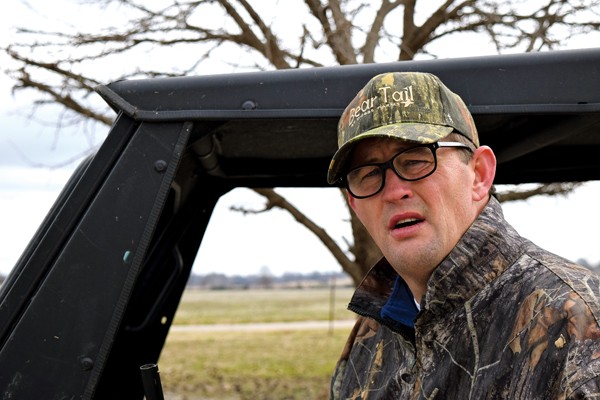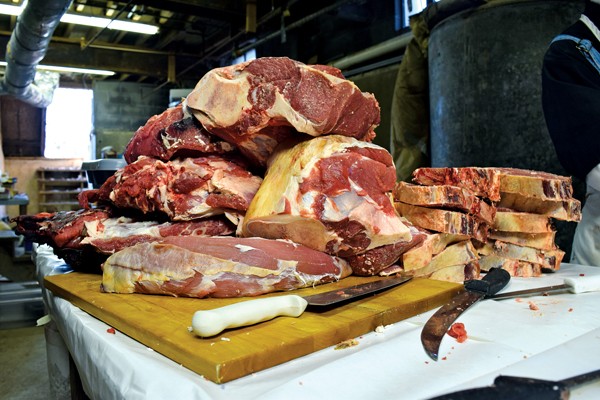After a three-year break, the Hill Country Boucherie and Blues Picnic will take place September 3rd at Home Place Pastures in Como, Mississippi.
“Boucherie is a Cajun word,” says Home Place Pastures owner Marshall Bartlett. “I think it’s actually a French word that means ‘butcher shop’ or ‘meat store.’ It’s been adapted to mean sort of a celebration. Cajun Acadians brought it down to the Cajun country. They would harvest a pig and cook it right there and dedicate the bounty of the whole animal, add music to make it festive. Just a big party.
“We’re doing the same thing. There’s no active harvesting going on, but we’re challenging our chefs to utilize those culinary traditions, utilize the whole animal, like nose-to-tail eating.”
The restaurant teams are from “Memphis to New Orleans and everywhere in between.” The first boucherie featured one chef and drew about 100 people. The last event drew around 1,000. Guests can pay $110 for a dinner ticket, which includes the music, or just pay $10 for the music after the dinner.
Dinner guests meet by the lake and pick up a two-ounce portion of each chef’s dish buffet-style. “They’re all labeled. At the end you vote on your favorite, and we give out prizes to the chef that wins. Afterward, you walk next door to the farm shed, where we have live music.”
Food will be available there, too. “Burgers and bologna sandwiches and beer. We’re keeping it pretty simple, pretty country.”
A native of Como, Bartlett says his boucherie is based on a family tradition at the Home Place, his family farm. In the fall, they held dove-hunt parties with “good food, good people — and we celebrated music in this area.”
The boucherie also harkens back to the annual picnic hosted by the late Othar Turner on his farm near Sardis, Mississippi. “He’d cook the whole goat, sell sandwiches, tons of beer.”
Bartlett learned “how people in the South don’t waste anything. They cook every part of the animal and make a lot of innovations in this process — delicious innovations and discoveries.
“We just wanted to figure out if we could bring all of that together in one cool event.”
Bartlett, who now lives in Memphis, started Home Place Pastures eight years ago. It produces “pastured pork and grass-fed beef” on 500 acres of his family’s 1,800-acre farm.
He added “Pastures” to “Home Place,” Bartlett says, “because we are trying to convert the road crop operation to a full regenerative grazing operation.”
Bartlett moved back to Como three years after he graduated from Dartmouth. “I loved the farm so much ’cause I grew up there and it meant the world to me. I didn’t want to see the agricultural legacy of my family go by the wayside.”
He’s the fifth generation on the farm, which dates to about 1871.
The family grows cotton, corn, and soybeans, but Bartlett wanted to build a brand using “local, humane, regenerative meat production.
“You’re using animal impact and focusing on soil health to run a farm like an ecosystem rather than a linear high-production model of one product like corn and cotton. In the process of doing all that, you really enhance the health of our watershed and our environment in general to promote biodiversity and combat climate change.”
Home Place Pastures also includes the Farm Store. “It’s a really cool butcher shop. We serve lunch four days a week, Thursday through Sunday.
“We’ve got house-made bologna sandwiches and our grass-fed burger. The fried pork chop sandwich is outstanding. We make all the meat, obviously. It’s raised and processed right here, so it’s pretty unique.”
Memphians also can order Home Place Pastures meat via its website and have it delivered to their home.
For more information on the Hill Country Boucherie and Blues Picnic, go to homeplacepastures.com.

 John Klyce Minervini
John Klyce Minervini  John Klyce Minervini
John Klyce Minervini  John Klyce Minervini
John Klyce Minervini  John Klyce Minervini
John Klyce Minervini